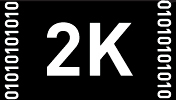

Thirty-six-year-old Jane Schoenbrun follows up their narrative feature debut, We're All Going to the World's Fair, with this solid sophomore effort that continues the filmmaker's exploration of how suburban kids of the Millennial generation and younger escape much of their uneasy childhood via an unhealthy obsession with screens. The story centers on introverted Owen (played by Ian Foreman as a child and Justice Smith as a teen) whose isolated 7th-grade existence in 1996 is forever altered when he crosses paths with Maddy (Brigette Lundy-Paine), a 9th-grader who turns him on to a TV show called The Pink Opaque. Though a kids' show on a Nickalodian-style cable channel, The Pink Opaque doesn't come on until 10:30 at night. Owen must slip away from his checked-out parents (a sickly Danielle Deadwyler and a frightening Fred Durst) under the guise of sleeping over at a classmate's house so he can go to Maddy's and watch the show.
The Pink Opaque is a terrific concept. It combines elements of Twin Peaks, Buffy the Vampire Slayer, and daytime tween fare like Sabrina the Teenage Witch or Are You Afraid of the Dark? But the show is more reminiscent of what we imagine when we think back on those programs than the actual shows themselves. Like Buffy, there's a monster of the week the teen heroes must vanquish; like Twin Peaks, the show is abruptly canceled after a deeply unsettling season-finale cliffhanger that's never resolved. The film jumps forward to 2008 when Owen and Maddy reconnect. They are both still obsessed with The Pink Opaque, but how much of what they remember about the show is accurate, and how much is what they've built up in their minds, or how much the show has taken over their psyche, is up for debate.
While I Saw the TV Glow unfolds linearly, for the most part, I would call this a dream film that follows dream logic. It captures an era in American suburban culture that I'm a little too old to have experienced firsthand. Screens and fictional TV shows certainly played a huge role in the young lives of folks in my generation, but I was living in a bit more of a mono-culture with fewer nitches and rabbit holes to get sucked into and way less toxic fan culture. Both of Schoenbrun's features capture such palpably deep feelings of loneliness and isolation that I simply don't remember experiencing in my own teenage years, though I spent a hell of a lot of time by myself. Part of this has to do with another sensation that permeates both of Schoenbrun's features—a sense of not being in control, which also seems specific to their generation and the generations coming after.
The imagery and flow of I Saw the TV Glow worked far better for me than We're All Going to the World's Fair. That first film almost felt more like a thought experiment than a movie, but it benefited from getting released at the peak of the COVID-19 lockdown era, capturing something of the isolated experience we were all going through while not being remotely about COVID-19. This new film hints that Schoenbrun may just be scratching the surface of their generational experience of loneliness, active imagination, and looking to screens for identity and self-actualization. There may be many more films of this ilk to come.
I would rate the movie higher were it not for a few things that really got in my way. The principal choice that derailed me was having Owen occasionally break the fourth wall and narrate his story, making sure we viewers are clear about where we are in time and what's happened. This seemed to break altogether the dreamlike spell the picture was casting each time it occurred. I'm at a complete loss as to why these pieces of exposition were required in a movie of this type. I've certainly never experienced a character in one of my dreams turning to me and updating me on how things have been progressing. But then again, maybe I'm just too old. Maybe kids today, raised on so many lazy mockumentary-stye sitcoms that can't go more than two minutes without a character describing their version of the scene we just saw playout, can't escape people directly addressing them and telling them things they could easily and more enjoyably figure out for themselves—even in their nightmares. That sure would be a nightmare for me!
With the sophomore outing, Jane Schoenbrun continues to creepily and effectively explore their generation's distinctive experience of loneliness, active imagination, and looking to screens for identity and self-actualization.




